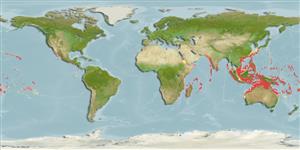Teleostei (teleosts) >
Anguilliformes (Eels and morays) >
Ophichthidae (Snake eels) > Ophichthinae
Etymology: Apterichtus: From the Greek απτερόν (apteron), without fins, and ίχθύς (ichtus, more correctly written ichthys; masculine), fish.
Eponymy: M D Klazinga was the Chief Engineer on board the ‘Siboga’, during the expedition (1899– 1900) on which the holotype was collected. Weber describes him as ‘vaillaint’ (brave), but fails to give his full names. (Ref. 128868), visit book page.
More on author: Weber.
Environment: milieu / climate zone / depth range / distribution range
Ecology
Marine; demersal; depth range 1 - 120 m (Ref. 86942). Tropical
Indo-Pacific: East Africa to the Marshall Islands (Ref. 2334); reported from the Hawaiian Islands (Ref. 58302) and Marqueses (Ref. 101270).
Size / Weight / Age
Maturity: Lm ? range ? - ? cm
Max length : 40.0 cm TL male/unsexed; (Ref. 2334)
Short description
Identification keys | Morphology | Morphometrics
Benthic (Ref. 58302). Forms congregations in confined sandy areas of sandy bottoms (Ref. 30874) where it buries itself using its pointed snout or its bony, sharp tail. May feed on small fishes, crabs, and prawns (Ref. 30874).
Life cycle and mating behavior
Maturity | Reproduction | Spawning | Eggs | Fecundity | Larvae
Randall, J.E., G.R. Allen and R.C. Steene, 1990. Fishes of the Great Barrier Reef and Coral Sea. University of Hawaii Press, Honolulu, Hawaii. 506 p. (Ref. 2334)
IUCN Red List Status (Ref. 130435: Version 2024-1)
Threat to humans
Harmless
Human uses
Tools
Special reports
Download XML
Internet sources
Estimates based on models
Preferred temperature (Ref.
123201): 24.3 - 28.8, mean 27.3 °C (based on 624 cells).
Phylogenetic diversity index (Ref.
82804): PD
50 = 0.5000 [Uniqueness, from 0.5 = low to 2.0 = high].
Bayesian length-weight: a=0.00091 (0.00039 - 0.00215), b=2.99 (2.79 - 3.19), in cm total length, based on LWR estimates for this (Sub)family-body shape (Ref.
93245).
Trophic level (Ref.
69278): 3.9 ±0.67 se; based on food items.
Resilience (Ref.
120179): High, minimum population doubling time less than 15 months (Preliminary K or Fecundity.).
Fishing Vulnerability (Ref.
59153): Low to moderate vulnerability (30 of 100).
